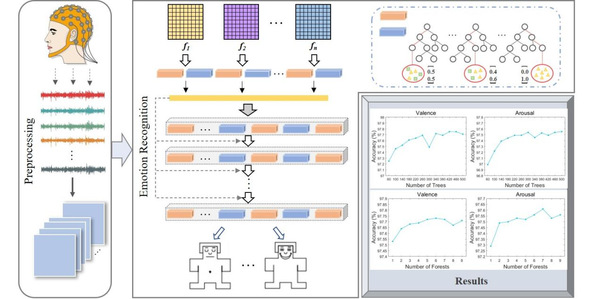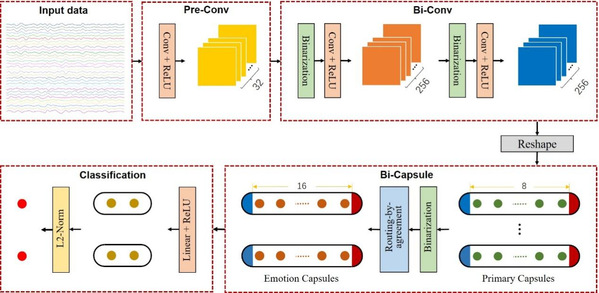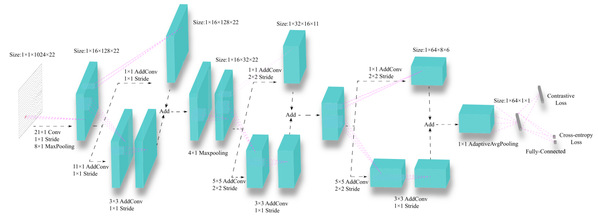Img-news
Img-news
Research Advances in Deep Learning-Based EEG Decoding
2023-11-16 浏览次数:11
“Brain Science and Brain-Inspired Research” has been listed as one of the seven “Frontier Science and Technology Areas” projects in the National “14th Five-Year Plan”. Electroencephalography (EEG) is an electrophysiological signal that can record brain activity, providing millisecond-level temporal resolution that matches the brain’s information processing. It also has the characteristics of non-invasiveness and portability. Decoding neural activity from EEG signals is a cutting-edge and highly challenging problem. In recent years, our research team in Biomedical Signal and Image Processing, including Chang Li, Yu Liu, Juan Cheng, and Rencheng Song, has achieved a series of research advancements in the field of deep learning-based EEG decoding. The relevant research findings have been published in internationally authoritative journals such as IEEE Transactions on Affective Computing (IF 13.990), IEEE Transactions on Industrial Informatics (IF 11.648), IEEE Journal of Biomedical and Health Informatics (IF 7.021), IEEE Transactions on Neural Systems and Rehabilitation Engineering (IF 4.528), IEEE Transactions on Cognitive and Developmental Systems (IF 4.546), Computers in Biology and Medicine (IF 6.698), Science China Information Sciences (IF 7.275), Measurement (IF 5.131), and other journals, achieving a positive academic impact.
In the field of EEG-based emotion recognition, the main research works include:
1)For addressing the insufficient spatiotemporal information mining and heavy reliance on a large amount of training data in existing EEG emotion recognition methods. Innovative methods based on attention mechanism convolutional recurrent neural networks and deep forest have been proposed, effectively improving recognition accuracy. The related works have been published in the internationally academic journals: IEEE Transactions on Affective Computing (14(1): 382-393, 2023) and IEEE Journal of Biomedical and Health Informatics (25(2): 453-464, 2021), with a total citation count over 230. One of the works has been selected as ESI highly cited paper.

Fig. 1: EEG emotion recognition method based on deep forest (IEEE JBHI 2021).
2)For addressing the limited capability of mining spatial relationship information in traditional convolutional neural networks, we innovatively conducted research on EEG emotion recognition methods based on Capsule Network. A series of novel methods based on capsule networks have been proposed, significantly improving recognition accuracy. The related research works have been published in IEEE Journal of Biomedical and Health Informatics (27(3): 1319-1330, 2023), Computers in Biology and Medicine (152: 106463, 2023; 143: 105303, 2022; 123: 103927, 2020), and Science China Information Sciences (65(4): 140405, 2022), with a total citation count over 120.

Fig. 2: EEG emotion recognition method based on binary capsule network (IEEE JBHI 2023).
3)For addressing the flaws of artificially designed network structures in existing deep learning methods, we introduced network architecture search (NAS) techniques into EEG emotion recognition research. We proposed two novel methods, e.g., NAS-based and Transformer-NAS-based, enhancing the flexibility and effectiveness of model design. The related research works have been published in IEEE Transactions on Affective Computing (DOI: 10.1109/TAFFC.2021.3130387) and IEEE Transactions on Industrial Informatics (DOI: 10.1109/TII.2022.3170422).

Fig. 3: Seizure prediction method based on additive networks and supervised comparative learning (IEEE TNSRE 2022).
In the field of EEG-based seizure prediction, the main research works include:
1)For addressing the issues of high computational complexity, insufficient utilization of label information, and low credibility of model output in existing deep learning-based seizure prediction methods. We proposed a method based on additive networks and supervised comparative learning, and a method based on model uncertainty learning, respectively. The related research works have been published in IEEE Transactions on Neural Systems and Rehabilitation Engineering (30: 1536-1547, 2022; 31: 180-191, 2023).
2)For addressing the issues of insufficient extraction of local and global information from EEG and inadequate utilization of spatiotemporal information while removing noise, methods based on Transformer-guided convolutional neural networks and spatiotemporal multilayer perceptron have been proposed. The related research works have been published in Measurement (203: 111948, 2022; 206: 112278, 2023).
3)For addressing the limited capability of mining spatial relationship information in convolutional neural networks, a method based on multi-channel feedback capsule networks for EEG seizure prediction has been proposed. The related research works have been published in IEEE Transactions on Cognitive and Developmental Systems (DOI: 10.1109/TCDS.2022.3212019).
In view of the series of innovative achievements mentioned above, our team was invited to write a comprehensive survey paper titled “Toward Open-World Electroencephalogram Decoding Via Deep Learning: A Comprehensive Survey” for the prestigious international journal IEEE Signal Processing Magazine (IF 15.204). The paper, published in Volume 39, Issue 2, pages 117-134 in 2022, systematically elucidates the current research status, challenges, and opportunities of utilizing deep learning models for EEG decoding in complex open-world environments.
Hyperlinks to the previously mentioned papers:
https://ieeexplore.ieee.org/abstract/document/9204431
https://ieeexplore.ieee.org/abstract/document/9096541
https://ieeexplore.ieee.org/abstract/document/9999486
https://ieeexplore.ieee.org/abstract/document/9626645
https://ieeexplore.ieee.org/abstract/document/9763316
https://ieeexplore.ieee.org/abstract/document/9787538
https://ieeexplore.ieee.org/abstract/document/9931737
https://ieeexplore.ieee.org/abstract/document/9721187
https://ieeexplore.ieee.org/abstract/document/9911679
https://www.sciencedirect.com/science/article/pii/S0010482520302663
https://www.sciencedirect.com/science/article/pii/S0010482522000956
https://www.sciencedirect.com/science/article/pii/S0010482522011714
https://www.sciencedirect.com/science/article/pii/S0263224122014749
https://www.sciencedirect.com/science/article/pii/S0263224122011447
https://link.springer.com/article/10.1007/s11432-021-3439-2
